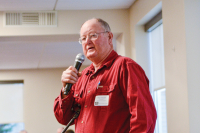Steep-slope ordinance slides out of reach
The likelihood of Macon County imposing development guidelines for houses and roads on steep mountainsides grew increasingly remote after the planning board, embroiled for months in a series of heated debates over the matter, tabled the proposed ordinance last week.
“We’re a hung jury, basically,” Planning Board Chairman Lewis Penland, in a fish-or-cut-bait moment, told the 10 members of the 13-member board who attended last week’s meeting.
Penland attempted to salvage at least a portion of the work done over the past two years by the planning board’s steep-slope subcommittee. He convinced the planning board to drop work on the proposed steep-slope ordinance, and instead work on general construction standards. Penland said the planning board would return to the steep-slope ordinance at a later date, but did not indicate whether that would be in six months, six years or 60 years from now.
The construction standards would govern dirt-disturbing activities, such as road building and house-pad building, by dictating how steep cut-and-fill slopes can be or ensuring house pads are properly compacted before foundations get poured. Macon County has had a number of poorly designed and built roads that have simply washed away or fallen off mountainsides in recent years.
The construction standards would still go a long way toward improving building practices. They date back to the steep-slope subcommittee, intended as a mere baseline for developing a set of more comprehensive steep-slope rules. Now, they might represent the sum total of what the planning board members can find common ground on when it comes to the steep-slope debate.
After an hour-and-a-half discussion, the planning board unanimously agreed with Penland’s recommendation to table the ordinance and study general construction guidelines — with the exception of surveyor Lamar Sprinkle, a vocal opponent of any suggestion raised at the planning board meetings. He abstained from voting.
Related Items
The construction standards, if adopted by the planning board and then by the Macon County Board of Commissioners, would become part of the already-existing soil erosion ordinance. The construction standards — unlike the steep-slope ordinance — don’t touch on controversial slope percentages or landslide-hazard maps.
Al Slagle, who served as chairman of the steep-slope subcommittee, endorsed Penland’s compromise suggestion but had his say about the matter first.
“What we came up with is squarely in the middle,” Slagle said of the subcommittee’s original recommendations. “It’s something that protects property rights, and the same time it’s efficient and as easy to use as possible — something that places the least possible burden on property owners.”
Susan Ervin, who like Slagle served on the subcommittee, also backed Penland’s compromise. She, too, defended the entire steep slope ordinance, defining it as “a very moderate proposal that limited the scope to the most critical aspects of slope development.”
Commissioner Bobby Kuppers, liaison for the commission board to the planning board, endorsed Penland’s suggestion, saying he believes construction standards would help solve development nightmares in Macon County.
He pointed to two particular recent construction projects that utilized questionable development practices: Wildflower subdivision off U.S. 441 and Blossomtown Road, above Ruby Cinemas.
“Can these be solved by construction standards? Yes, I think they can,” Kuppers said, adding he’d take the matter up with the full board of commissioners in a meeting this week.
Sprinkle, however, issued a flat contradiction of the expert opinion of others who have surveyed the landslides and building issues in the 2,200-acre Wildflower subdivision, defending the development. He said people just weren’t mentioning all the good roads built there, but were concentrating on the ones that had actually fallen off the mountains.
“There are some problem places, but most of those roads are all right,” Sprinkle said.
His assertion was greeted with astonishment by other board members, including Slagle, who said he totally disagreed with Sprinkle.
“There are a tremendous number of those fill slopes that are failing,” Slagle said.
How did we get here from there?
By homing in on general construction standards instead of an overarching steep-sleep ordinance, Macon County Planning Board Chairman Lewis Penland steered his rickety planning-board ship away from two points it was foundering on. One was how steep a slope had to be before it would trigger safety regulations. The other was how to incorporate the landslide hazard maps.
The state started mapping the probability of landslides in the state’s mountainous counties following the Peeks Creek disaster in Macon County in 2004, when five people were killed and 15 houses were destroyed. While experts agreed the Peeks Creek landslide was a natural occurrence triggered by excessive rainfall, the event laid bare a fundamental, and haunting, safety question for local governments: should people be discouraged from building in areas identified as hazardous?
Only Macon, Watauga and Buncombe counties had maps completed before the GOP-led General Assembly this year cut the project.









